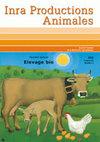Le secteur laitier français à la croisée des chemins
IF 0.6
4区 农林科学
Q3 Agricultural and Biological Sciences
引用次数: 14
Abstract
Given the planned abolition of milk quotas in 2015, the French dairy sector is going through a crucial period in its history, mingling doubts and hopes. The rapid decline in the number of dairy farms (at 5 % per year over the previous decade), the increased price volatility, the negative environmental implications of the intensification, the increasing competition from neighbouring countries (including Germany) have cast doubt on the French players as to the strategies to be deployed to effectively prepare the future. The French dairy sector has nevertheless many assets that will help it rebound: a high level of consumption of dairy products per capita per year (also due to an exceptional diversity of processed products); a wide variety of echnical models, with a historical adaptation of farms to natural conditions (climate, agronomic potential…); a high potential of production development due to a low population density in many rural areas, the abundance of available forage areas and possible substitutions between agricultural productions; some improvements in scientific knowledge and technological know-how in enterprises; some French firms are leaders at the international level; a government commitment in favour of new contractual relationships between producers and firms in order to manage supply without the milk quota system. On the eve of the abolition of milk quotas, the aim of this paper was first to propose an analysis of the current economic situation of the French dairy sector (strengths, weaknesses, diversity of models) and, second, to examine the conditions of the implementation of the contractualisation system.法国乳品行业正处于十字路口
鉴于计划在2015年取消牛奶配额,法国乳制品行业正在经历其历史上的关键时期,疑虑和希望交织在一起。奶牛场数量的快速下降(在过去十年中每年下降5%),价格波动的增加,加剧的负面环境影响,来自邻国(包括德国)的日益激烈的竞争,使法国玩家对部署有效准备未来的战略产生了怀疑。尽管如此,法国乳制品行业仍有许多资产可以帮助其反弹:每年人均乳制品消费量高(也是由于加工产品的异常多样化);多种多样的技术模式,具有农场对自然条件(气候、农艺潜力……)的历史适应性;由于许多农村地区人口密度低、可利用的饲料面积丰富以及农业生产之间可能的替代,生产发展潜力很大;企业的科学知识和技术诀窍有所提高;一些法国公司在国际上处于领先地位;政府承诺在生产者和公司之间建立新的合同关系,以便在没有牛奶配额制度的情况下管理供应。在取消牛奶配额的前夕,本文的目的是首先提出对法国乳制品行业当前经济状况的分析(优势,劣势,模式的多样性),其次,检查实施合同化制度的条件。
本文章由计算机程序翻译,如有差异,请以英文原文为准。
求助全文
约1分钟内获得全文
求助全文
来源期刊

Inra Productions Animales
Multiple-
CiteScore
1.30
自引率
33.30%
发文量
0
审稿时长
>36 weeks
期刊介绍:
This journal publishes scientific update reports, results of experiments and their possible applications, analyses on topical issues and presentation of research, information on scientific events and new publications.
INRA Productions Animales deals with all species of zootechnical interest (herbivores, monogastrics and fish), covering feed and nutrition, physiology, pathology, genetics, production techniques, product quality and production economics.
 求助内容:
求助内容: 应助结果提醒方式:
应助结果提醒方式:


